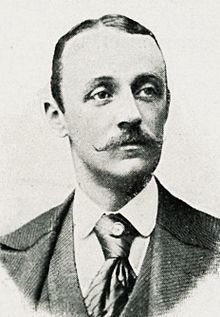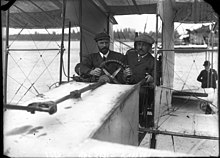Ernest Archdeacon

Ernest Archdeacon (* 1863 in Paris , † 1950 in Versailles ) was a prominent French lawyer of Irish descent and an automobile and aviation pioneer in France before the First World War . He made his first balloon flight at the age of 20. Archdeacon copied the 1902 Wright No. 3 gliders with little success. Together with Gabriel Voisin , he developed many early aircraft. Considered France's leading promoter and sponsor of aviation, he donated the Coupe d'Aviation Ernest Archdeacon and Deutsch de la Meurthe-Archdeacon prizes .
Another contribution to aviation was the Aéro-Club de France , the oldest aviation club in the world, which he co-founded in 1898.
In 1906 he developed a "propeller on a motorcycle", the Archdeacon Aéromotocyclette Anzani , which reached a top speed of 79.5 km / h in Achères-la-Forêt .
On May 29, 1908, Archdeacon became the first passenger in an airplane in Europe when he was taken to the airfield in Issy-les-Moulineaux by Henri Farman .
Life
Adolescent years
Archdeacon was born and raised in Paris. He studied law and planned a career in court. However, his enthusiasm for research led him to automobile sports, ballooning and aviation. He was friends with the steam car designer Léon Serpollet (1858–1907), whom he accompanied in a Peugeot Type 1 on a winter trip from Paris to Lyon in January 1890 to see the production facilities. The arduous tour, interrupted by numerous breakdowns, is likely to have been the first motorized business trip in history.
He took part in several long-distance trips with automobiles. These city-to-city trips were designed as reliability tests. He drove a Delahaye in the Paris – Marseille – Paris race , which took place between September 24 and October 3, 1896. 1710 km had to be covered in 10 daily stages; Archdeacon was seventh with a time of 75 hours, 29 minutes and 48 seconds. The winner Émile Mayade on Panhard was the only one who needed less than 68 hours to cross the finish line. At the circuit race Nizza-Castellane-Nice on March 21, 1899 over 120.7 km he was eighth, also on Delahaye.
Aviation sponsor
He made his first balloon flight at the age of 20. In April 1900, the Aéro-Club de France announced the Deutsch-de-la-Meurthe Prize of 100,000 French francs for the first flying machine that covered the route from Saint-Cloud to the Eiffel Tower and back in less than 30 minutes. In September 1901, Alberto Santos-Dumont completed the route in 30 minutes and 42 seconds.
When he heard about the Wright brothers from Octave Chanute , he decided to encourage the development of propulsion-powered aircraft in France. Therefore, in January 1904, an article by François Peyrey appeared in the issue of La Vie au Grand Air magazine entitled “A new sport - Soaring” (Un nouveau sport - Le vol plané). He reports on the request made by the aviator Captain Ferber (17th Alpine Battery) in 1903, “Don't let the Americans rule the aviation.” Archdeacon responded by donating 3,000 francs to the Archdeacon committee of the Aéro-Club in October 1904 de France to sponsor aviation competitions. In detail, prizes were awarded for the first flights over 25 m and 100 m (won by Santos-Dumont , 1906) and the first circular flight over one kilometer (won by Farman , 1908).
Glider
In 1903 Archdeacon acquired an imperfect copy of the retired Wright glider in 1902 from Monsieur Dargent at the Chalais-Meudon military aircraft company (balloons and planes) . It was a double-decker with an ash frame covered with silk and braced with piano strings. In the magazine La Vie au Grand Air it was described as follows: “The two convex wings from front to rear have a span of 7.5 m with a width of 1.4 m and a vertical distance of 0.4 m. The total area is 22 m². It has 2 tail units. The horizontal rudder on the front for vertical direction and as a landing flap for speed reduction. The vertical rudder at the rear of the aircraft ensures changes of direction in the horizontal axis. The aircraft is in spite of the low weight of 34 kg very stable. "
The first flight attempts with the Wright glider were carried out in April 1904 in the dunes of Merlimont near Berck-sur-Mer . The participants were Gabriel Voisin and Capitaine Ferdinand Ferber .
In March 1905 he commissioned another glider from Voisin , which was again a double-decker with a horizontal stabilizer in the bow, but had an additional stabilizer and rudder to increase stability. Archdeacon and Gabriel Voisin integrated these innovations into the box frame. However, the glider broke in the air on the first attempt at flight.
After the initial successes in Berck-sur-Mer , they attached swimmers to the hull and successfully tested the glider on the Seine in Boulogne-Billancourt between the bridges of Saint-Cloud and Sèvres . They took care of the propulsion by boat tow. The maximum flight height was 6 m with a covered distance of 200 m. The glider was damaged in another test and has never been used again.
Motorized flight
In 1903, Ernest Archdeacon and the Aéro-Club de France issued a new award, the Coupe d'Aviation Ernest Archdeacon , a silver trophy for the first flight over 25 m by a motor-powered aircraft. The prize was won on November 12, 1906 by Alberto Santos-Dumont in Bagatelle. The aircraft was a Santos-Dumont 14-bis biplane.
The Aéro-Club de Franc immediately issued a new price. It was 1,500 francs for the first 100 m flight. On October 26, 1907, Henri Farman flew a distance of 771 m.
In October 1904, Ernest Archdeacon increased the prize of the Deutsch de la Meurthe-Archdeacon prize to 50,000 francs. The prize was to be awarded to the person who covered a 1 km circuit in a motor-powered airplane. The sum was the equivalent of a worker in Paris for 20 years. Archdeacon and Henry Deutsch de la Meurthe had found that so far all flights have only been "straight flights". The intention of the advertised prize money was that an aircraft should be developed that was able to make changes of direction. Therefore the winner of the prize money should fly a closed circle. The prize was won by Henri Farman on January 13, 1908 with his Voisin-Farman I on the airfield in Issy-les-Moulineaux . In Europe at that time one gave the reports from the United States, according to which corresponding flight performances z. B. had been provided with the Wright Flyer II by the Wright brothers as early as September 1904, no faith.
At the military training area in Issy-les-Moulineaux , Archdeacon used a 60-horsepower engine in March 1905 to start a Wright glider weighed down with sand on a rope. He soared like a kite up to 30 m before falling.
Archdeacon Aéromotocyclette Anzani
In 1906 Archdeacon developed a propeller motorcycle that reached a top speed of 79.5 km / h in Achères-la-Forêt . This air motorcycle was based on a Buchet motorcycle and was equipped with a 6 hp Anzani aircraft engine.
Skepticism towards the Wright brothers
In 1906, the mood against the Wright brothers also hit the press. European magazines, above all the French, raised the mood against them and called them “bluffers”. Despite the published reports and evidence, Archdeacon was skeptical, expressed itself in various articles and wrote in 1906 that the French would conduct the first public powered flight .
The Paris edition of the New York Herald summarized Europe's opinion on the Wright brothers on February 10, 1906 as follows:
"The Wright have flown or they have not flown. They possess a machine or they do not possess one. They are in fact either fliers or liars. It is difficult to fly. It's easy to say, 'We have flown.' "
“The Wright brothers either flew or not. They own a flying machine or they don't have one. Indeed, they are either fliers or liars. It's difficult to fly. It's so easy to say, 'We flew!' "
In August 1908, Wilbur Wright demonstrated with the Wright Model A at the Les Hunaudières racetrack near Le Mans that it was very capable of flying. Archdeacon announced that he had wronged them.
See also
- Wright Brothers (main article)
- History of aviation
literature
- Chadeau Emmanuel: The aviation industry in France 1900–1950 . Bleriot to Dassault, Paris, Fayard, 1987.
- Collectif, Les Grands Dossiers de l'Illustration, L'épopée de l'Aviation, histoire d'un siècle 1843–1944, Sefag et l'Illustration, 1987.
- La Vie au Grand Air , No. 280, January 21, 1904.
- La Vie au Grand Air , No. 285, February 25, 1904.
- La Vie au Grand Air , No. 293, April 21, 1904.
- La Vie au Grand Air , No. 342, March 30, 1905.
- La Vie au Grand Air , No. 418, dated September 22, 1906.
Web links
- http://www.carnetdevol.org/aerostation/aviation.htm
- SANTOS DUMONT and the False Primacies. ( Memento from October 20, 2010 in the Internet Archive )
- http://www.centennialofflight.gov/user/fact_apr.htm
- http://www.earlyaviators.com/eferber.htm
- http://www.centennialofflight.gov/essay/Dictionary/Archdeacon/DI49.htm
- OzeBook
- http://www.ctie.monash.edu.au/hargrave/farman.html
- The Pioneers - An Anthology Ernest Archdeacon (1863-1950)
- gazoline.net: Serpollet, à tout vapeur (French) (accessed November 20, 2013)
photos
- Archdeacon-Voisin Glider, c.1904
- Archdeacon-Voisin Glider, c.1904. L'aéroplane Archdeacon, construit a Chalais-Meudon
- Archdeacon-Voisin Glider, Issy les Moulineaux, March, 1905
- Archdeacon-Voisin Glider, Issy les Moulineaux, March, 1905
- Archdeacon-Voisin Glider, Issy les Moulineaux, March, 1905, Towed by car with sand bag load
- Henry Farman and Ernest Archdeacon, Issy-les-Moulineaux, 1908. On 29 May Farman took Archdeacon as 'the first air passenger in Europe'.
Individual evidence
- ^ Serpollet, à tout Vapeur. Retrieved December 6, 2014 .
- ↑ 1896 Grand Prix and Paris Races; Paris-Marseilles-Paris Trail. (No longer available online.) Archived from the original on September 24, 2015 ; Retrieved April 4, 2015 .
- ↑ 1899 Grand Prix and Paris Races; Nice-Castellane-Nice. (No longer available online.) Archived from the original on September 24, 2015 ; Retrieved April 4, 2015 .
- ^ A b The Men. In: Those Magnificent Men in their Flying Machines. Retrieved August 29, 2020 .
- ^ The Prize Patrol. Retrieved December 6, 2014 .
Archdeacon also used his wealth to fund a number of prices, all offered in October 1904.
| personal data | |
|---|---|
| SURNAME | Archdeacon, Ernest |
| BRIEF DESCRIPTION | French aviation pioneer |
| DATE OF BIRTH | 1863 |
| PLACE OF BIRTH | Paris |
| DATE OF DEATH | 1950 |
| Place of death | Versailles |


